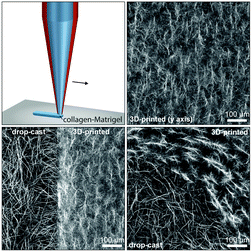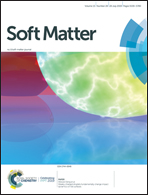Microextrusion printing cell-laden networks of type I collagen with patterned fiber alignment and geometry†
Abstract
Type I collagen self-assembles into three-dimensional (3D) fibrous networks. These dynamic viscoelastic materials can be remodeled in response to mechanical and chemical signals to form anisotropic networks, the structure of which influences tissue development, homeostasis, and disease progression. Conventional approaches for fabricating anisotropic networks of type I collagen are often limited to unidirectional fiber alignment over small areas. Here, we describe a new approach for engineering cell-laden networks of aligned type I collagen fibers using 3D microextrusion printing of a collagen-Matrigel ink. We demonstrate hierarchical control of 3D-printed collagen with the ability to spatially pattern collagen fiber alignment and geometry. Our data suggest that collagen alignment results from a combination of molecular crowding in the ink and shear and extensional flows present during 3D printing. We demonstrate that human breast cancer cells cultured on 3D-printed collagen constructs orient along the direction of collagen fiber alignment. We also demonstrate the ability to simultaneously bioprint epithelial cell clusters and control the alignment and geometry of collagen fibers surrounding cells in the bioink. The resulting cell-laden constructs consist of epithelial cell clusters fully embedded in aligned networks of collagen fibers. Such 3D-printed constructs can be used for studies of developmental biology, tissue engineering, and regenerative medicine.



 Please wait while we load your content...
Please wait while we load your content...
